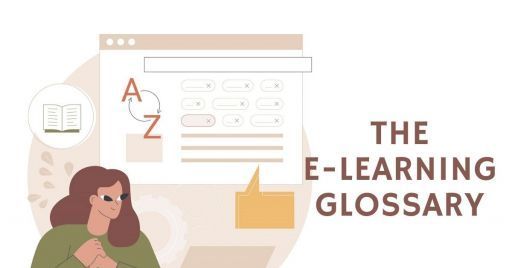
The eLearning Glossary - Part III - Chapter Two

eLearning is a constantly evolving field. The same applies to the terms used in the field of distance learning.
Here is the continuation of our last article The eLearning Glossary - Part III.
To discover more terms in use in the world of eLearning also refer to The eLearning Glossary - Part I (2018) and The eLearning Glossary - Part II (2020).
Let's delve into the terminology without further preamble with the second and final part of our glossary 2022.
1. MOOC
MOOC stands for 'Massive Open Online Course'. The idea is to make educational and training materials on a subject available to anyone free of charge. The term MOOC was coined in 2008 and MOOCs started to become popular teaching tools in 2012: many universities started to create them.
Many platforms described as MOOCs are not MOOCs at all: learning materials are made available but are not structured as a 'course' or are not free and 'open' to all.
2. Multimedia learning / Learning
According to a cognitive theory first popularised by Richard E. Meyer in his book Multimedia Learning (2001), multimedia learning is based on three main assumptions
- there are two separate channels (visual and auditory) for processing information;
- the capacity of the channels is limited;
- learning is an active process of filtering, selecting, organising and integrating information.
3. Multi-tenancy LMS
In software, the term multi-tenancy refers to a single application (in this case, the LMS) shared by several groups of users who each experience their own customised learning environment. That is, different user groups can have different learning portals (each with its own login portal, features, user rights, content, look & feel, etc.).
This reduces the cost and time needed to adapt the learning experience to different teams, organisations or even customers.
4. Next Generation Digital Learning Environment (NGDLE)
L&D professionals' biggest criticism of learning management systems is their closed nature, which requires an additional administration process, compared to other business and HR systems.
The idea of the Next Generation Digital Learning Environment (NGDLE) is to open an ecosystem of learning and HR performance tools integrated with open standards (single sign-on, SSO) to reduce the segregation of learning assessment, collaboration, feedback and communication in general. Some LMSs are already open to integrations with other software, such as DynDevice LMS.
5. Off-the-shelf content
Standard, non-customised online courses. Often called 'generic' or 'off-the-shelf', off-the-shelf content has been developed to be useful to a relatively large user base and multiple organisations. The opposite is customised content, made for a specific organisation.
6. Offline Learning
This term refers to two aspects:
- traditional face-to-face learning that does not involve software applications;
- digital learning that does not require a constant connection to the Internet, thanks to previously downloaded online courses.
7. On-The-Job Training (OJT)
Employee training that takes place during the performance of work tasks. A supervisor is usually present to provide guidance and practical support.
8. Onboarding
The process of bringing a new employee, partner or customer into an organisation or the induction phase with respect to the organisation's products and services. Onboarding generally includes orientation and training on topics related to the company, its operational processes and business offerings.
9. Scenario-based training
A scenario or learning scenario is a framework of (sometimes immersive) exercises in which the learning experience is centred on a realistic situation or story.
10. Self-paced learning / Self-directed learning
Self-paced learning (or self-directed learning)allows the learner to proceed with the learning experience at their own pace and have more control over their learning experience, resulting in improved engagement and learning retention.
11. SME
SME stands for Subject Matter Expert . In corporate eLearning, SME's provide input to help create online courses. Depending on professionalism and figure, anyone can act as an SME.
12. Successive Approximation Model (SAM)
A more agile approach to eLearning course development than the ADDIE process. The SAM focuses on an iterative method that offers several advantages
- greater visibility to the project team
- faster launch times.
Using a cyclic process, SAM comprises two models:
- SAM1: ideal for smaller teams or projects, it is the simplest process. It comprises three iterations of the process: analysis, design and development.
- SAM2: for more complex projects, this process involves eight iterations divided into three phases: preparation, iterative design and iterative development.
13. Validated Learning Management System (VLMS)
Many companies, e.g. in the food, pharmaceutical or medical sector, have to meet strict regulatory requirements that all processes leading to the production of a product must be documented and verified at all times. This also applies to employee training, which is an essential factor in the quality management process.
A validated learning management system (VLMS) enables organisations to make training processes compliant with these stringent requirements.
14. WBT
WBT stands for Web-Based Training, or eLearning. WBT is a learning programme that is delivered over the web, either via the Internet or via a corporate intranet.
15. 70:20:10 learning
The 70:20:10 learning model states that the ideal proportions for adult learning methods should be:
- 70% experiential learning,
- 20% social learning,
- 10% formal learning.
Training should be derived mostly from learning on the job, partly from interactions with others and only minimally from structured training events.
Translated with www.DeepL.com/Translator
Did you like this article? Sign up for the newsletter and receive weekly news!
Subscribe to NewsletterComments:
No comments are in yet. You be the first to comment on this article!